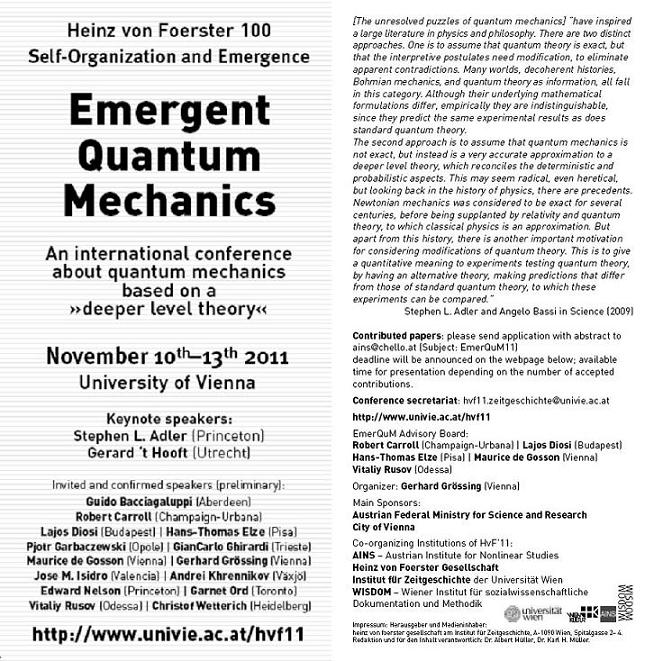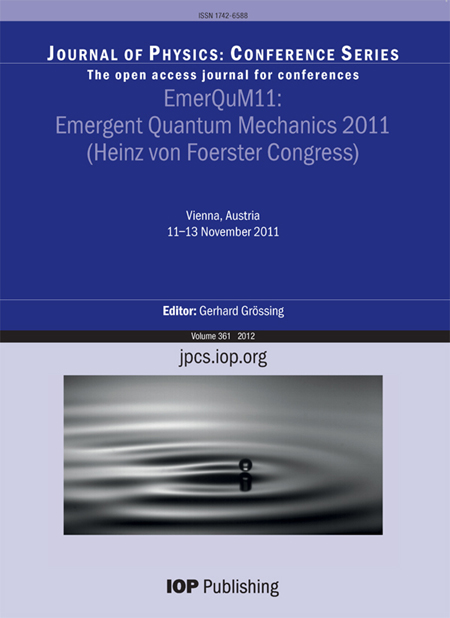Conference Emergent Quantum Mechanics (EmerQuM11 or EmQM11)
On the occasion of Heinz von Foerster’s 100th birthday
10 – 13 November 2011, University of Vienna, Austria
The theme of „emergent quantum mechanics“ is, we believe, an appropriate present-day topic, which can both serve as an illustration of von Foerster’s intellectual heritage and, more generally, as a means to point towards promising future directions in physics. We intend to bring together many of those physicists who are interested in or work on attempts to understanding quantum mechanics as emerging from a suitable classical (or, more generally: deeper level) physics, i.e., without the sometimes tedious discussions in conferences on quantum foundations, where the possibility of an emergent quantum mechanics is not even considered as a serious research topic.

Organizer
Gerhard Grössing (AINS)
Scope
[The unresolved puzzles of quantum mechanics] “have inspired a large literature in physics and philosophy. There are two distinct approaches. One is to assume that quantum theory is exact, but that the interpretive postulates need modification, to eliminate apparent contradictions. Many worlds, decoherent histories, Bohmian mechanics, and quantum theory as information, all fall in this category. Although their underlying mathematical formulations differ, empirically they are indistinguishable, since they predict the same experimental results as does standard quantum theory.
The second approach is to assume that quantum mechanics is not exact, but instead is a very accurate approximation to a deeper level theory, which reconciles the deterministic and probabilistic aspects. This may seem radical, even heretical, but looking back in the history of physics, there are precedents. Newtonian mechanics was considered to be exact for several centuries, before being supplanted by relativity and quantum theory, to which classical physics is an approximation. But apart from this history, there is another important motivation for considering modifications of quantum theory. This is to give a quantitative meaning to experiments testing quantum theory, by having an alternative theory, making predictions that differ from those of standard quantum theory, to which these experiments can be compared.”
Stephen L. Adler and Angelo Bassi in Science (2009)
Invited Lectures
Guido Bacciagaluppi (Aberdeen) | Robert Carroll (Urbana-Champaign) | Lajos Diósi (Budapest) | Hans-Thomas Elze (Pisa) | Piotr Garbaczewski (Opole) | GianCarlo Ghirardi (Trieste) | Maurice de Gosson (Vienna) | Gerhard Grössing (Vienna) | Basil Hiley (London) | Bei-Lok Hu (College Park) |
José M. Isidro (Valencia) | Andrei Khrennikov (Växjö) | Edward Nelson (Princeton) | Theo Nieuwenhuizen (Amsterdam) | Garnet Ord (Toronto) | Vitaly D. Rusov (Odessa) | Christof Wetterich (Heidelberg)
Contributed papers
Richard D. Bateson (London) | Agung Budiyono (Saitama) | Alexander Burinskii (Moscow) | John Bush (Cambridge) | Ana María Cetto (Mexico) | Catalina Curceanu (Frascati) | Marek Czachor (Gdansk) | Mark Davidson (Palo Alto) | Alexander Davydov (Rockville) | Mark J. Everitt (Loughborough, Cairo) | Manfried Faber (Vienna) | Felix Finster (Regensburg) | Lakhdar Gaffour (Sidi-Bel-Abbes) | Petr Hajicek (Berne) | Werner A. Hofer (Liverpool) | Louis H. Kauffman (Chicago) | Helmut Rauch (Vienna) | Ángel S. Sanz (Madrid) | Fabio Scardigli (Taipei) | Dieter Schuch (Frankfurt) | Herbert Schwabl (Vienna) | Mike Towler (Cambridge) | Giuseppe Vitiello (Salerno)
Posters
Andrey Akhmeteli (Houston) | Irina Basieva (Växjö) | Alain Bérard (Metz) | Andrew Beckwith (Houston) | Jarek Duda (Cracow) | Shan Gao (Sydney) | Konstantin A. Lukin (Kharkiv, Ukraine) | William McHarris (East Lansing) | Johannes Mesa Pascasio (Vienna) | Roumen Tsekov (Sofia)
Conference proceedings
Journal of Physics: Conference Series

AINS contributions
The Quantum as an Emergent System
Double slit interference is explained with the aid of what we call „21st century classical physics“. We model a particle as an oscillator („bouncer“) in a thermal context, which is given by some assumed „zero-point“ field of the vacuum. In this way, the quantum is understood as an emergent system, i.e., a steady-state system maintained by a constant throughput of (vacuum) energy. To account for the particle’s thermal environment, we introduce a „path excitation field“, which derives from the thermodynamics of the zero-point vacuum and which represents all possible paths a particle can take via thermal path fluctuations. The intensity distribution on a screen behind a double slit is calculated, as well as the Quantum features derived from the classical model of a bouncer-walker coupled to a zero-point fieldtrajectories and the probability density current. Further, particular features of the relative phase are shown to be responsible for nonlocal effects not only in ordinary quantum theory, but also in our classical approach.
G Grössing, S Fussy, J Mesa Pascasio and H Schwabl
The Quantum as an Emergent System
Gerhard Grössing 2012 J. Phys.: Conf. Ser. 361 011001
Quantum features derived from the classical model of a bouncer-walker coupled to a zero-point field
In our bouncer-walker model a quantum is a nonequilibrium steady-state maintained by a permanent throughput of energy. Specifically, we consider a „particle“ as a bouncer whose oscillations are phase-locked with those of the energy-momentum reservoir of the zero-point field (ZPF), and we combine this with the random-walk model of the walker, again driven by the ZPF. Starting with this classical toy model of the bouncer-walker we were able to derive fundamental elements of quantum theory [1]. Here this toy model is revisited with special emphasis on the mechanism of emergence. Especially the derivation of the total energy hbarωo and the coupling to the ZPF are clarified. For this we make use of a sub-quantum equipartition theorem. It can further be shown that the couplings of both bouncer and walker to the ZPF are identical. Then we follow this path in accordance with Ref. [2], expanding the view from the particle in its rest frame to a particle in motion. The basic features of ballistic diffusion are derived, especially the diffusion constant D, thus providing a missing link between the different approaches of our previous works [1, 2].
H Schwabl, J Mesa Pascasio, S Fussy and G Grössing
Quantum features derived from the classical model of a bouncer-walker coupled to a zero-point field
H Schwabl et al 2012 J. Phys.: Conf. Ser. 361 012021
Classical Simulation of Double Slit Interference via Ballistic Diffusion
Based on a proposed classical explanation, the quantum mechanical „decay of the wave packet“ is shown to simply result from sub-quantum diffusion with a specific diffusivity varying in time due to a particle’s changing thermal environment. The exact quantum mechanical intensity distribution, as well as the corresponding trajectory distribution and the velocity field of a Gaussian wave packet are therewith computed. We utilize no quantum mechanics, but only familiar simulation techniques for diffusion, e.g., finite differences or coupled map lattices (CML).
J Mesa Pascasio, S Fussy, H Schwabl and G Grössing
Classical Simulation of Double Slit Interference via Ballistic Diffusion
J Mesa Pascasio et al 2012 J. Phys.: Conf. Ser. 361 012041